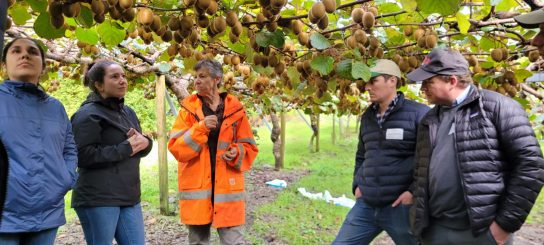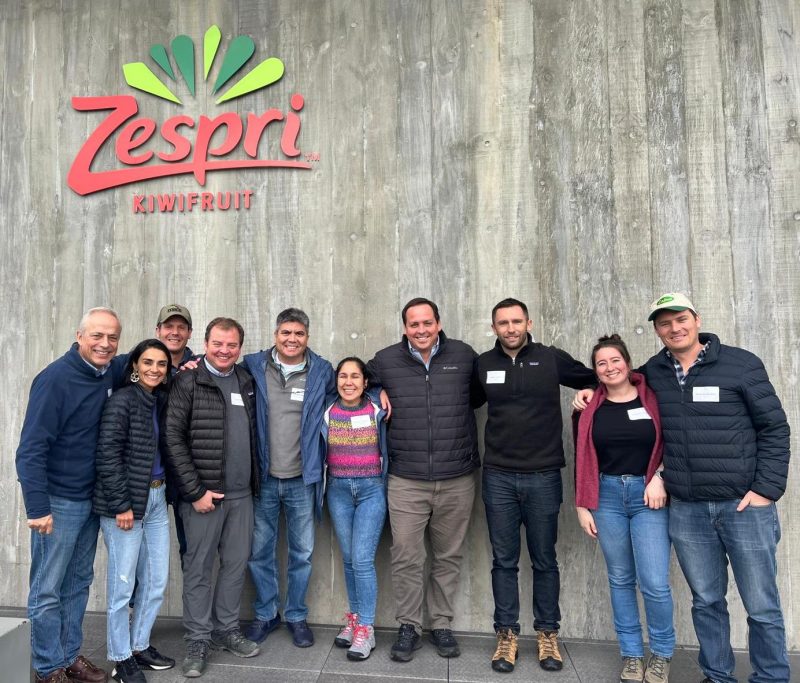To learn about the techniques for successful marketing of the New Zealand kiwifruit industry and to get closer to the production and post-harvest processes, the Chilean Fruit Kiwi team conducted a technical visit to Zespri, in which growers and technical experts participated from the company’s eight member companies.
“This visit is part of a collaboration that will rebuild the relationship of the two Kiwi industries and allow us as a team and Jespri to exchange experiences and knowledge while addressing issues of common concern. In total, ten delegations from the team visited New Zealand, bringing together producers and professionals from the production, post-harvest and commercial sectors. “Our visit focused on getting to know the process of fruit production and handling until it is sent to its destination; to showcase the products we can integrate into our processes, as our models are different,” said Carlos. Crusad noted.
The Chilean delegation visited three packaging plants in New Zealand called Postharvest. “Zespri’s model is that they don’t have any of their own infrastructure apart from their offices, the rest comes from service providers, and Zespri tells them what they need to do in terms of quality and packaging, according to the target markets” observed Cruzat.
New Zealand’s kiwifruit industry’s operations differ from Chile’s in terms of productivity and fruit centers, “where there are service providers (third parties) involved in the entire process. For example, management of some departments, applications of chemicals, pruning or harvesting, and providing a packing service, always Under the technical direction of Zespri, set with the aim of achieving the standards. Therefore, the producers have third-party services and equipment, as in Chile, they do not have permanent employees, but rather they operate on the basis of service provision or they do part of the work on their own, mostly 3 The first 5 hectares are for small producers,” he opined.
According to Creuzat, producers in New Zealand are more nuclear, and contractors are dedicated to providing services to 10 brix, more dry matter and less emphasis on stability. “Fruits with higher physiological maturity have better storage and allow use of fewer tools for storage, which increases cost,” he added.
On the other hand, the agronomist observed that there are different climatic conditions between the two countries that affect the onset and parameters of harvest. “They have a warm autumn, which allows us to harvest later. In our case, it cools down early in the autumn and we have to harvest earlier, but the funny thing is that there is a good accumulation of dry matter from the beginning of summer. So, it is a fruit with a very high flavor potential” The manager pointed out.
On the other hand, Zespri’s incentive system based on the type of fruit delivered to the grower in New Zealand creates continuous improvement in the internal and external quality of the fruit, he explained.
“Ultimately, this visit allowed us to better understand the Kiwi industry in New Zealand in order to strengthen our country’s strategy and thus focus on providing consumers with a good consumer experience. Therefore, the challenge for Chile – considering our conditions that are different both in terms of industry design and climate and production; our product customer It’s about how we make sure it’s satisfying and an option for the market, that is, an alternative. That’s what we’re working on as a team and looking at our realistic model as an industry,” Crouzat explained.
The president of the group observed today, “There are producers and member companies of the group who are investing and betting on creating a new future for the Chilean kiwi industry. Together with the Catholic University, they plan to incorporate the technologies that the group has set up at the service of partners to add value to the kiwi and give it more competitiveness.”
At the next “Kiwi Day” to be held in Monticello on August 20, 2024, organized in partnership with RedAgrícola, the Kiwi Fruit Group of Chile will explore the challenges for the national industry of this super fruit. Registration for participation (as a spectator or an exhibitor at the event) They are open. Click here for more information and registration
News in pictures


More articles

“Typical beer advocate. Future teen idol. Unapologetic tv practitioner. Music trailblazer.”

